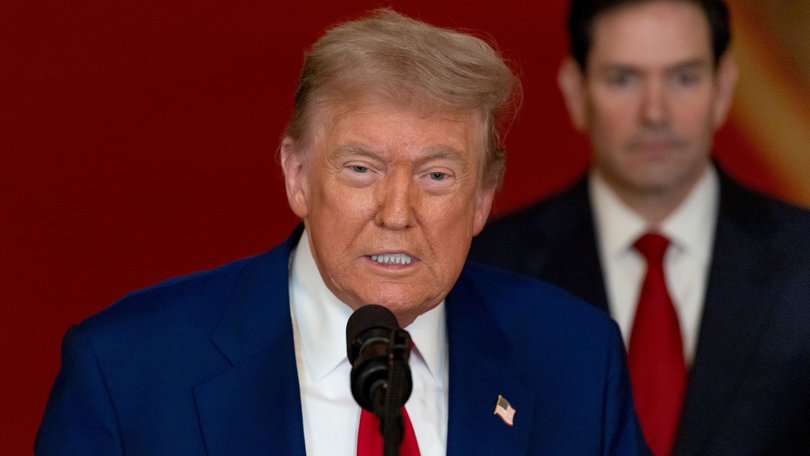How Donald Trump pivoted from bombing Iran to announcing a ceasefire with Israel within hours

In just 48 hours, US President Donald Trump pivoted from an unprecedented bombing of Iranian nuclear facilities to announcing a ceasefire between Israel and Iran, resulting in a flurry of diplomatic activity that left allies and adversaries scrambling to keep up.
Mr Trump’s Monday evening announcement of the ceasefire, which appears to be holding despite breaches by both sides, reflects his mercurial decision-making process, which current and former officials say is unorthodox even by his standards.
The President has largely sidestepped the traditional foreign policy establishment and the intelligence community in dealing with the Iran crisis. And in proclaiming victory and announcing major foreign policy moves, he has posted missives on social media rather than going through diplomatic channels.
Sign up to The Nightly's newsletters.
Get the first look at the digital newspaper, curated daily stories and breaking headlines delivered to your inbox.
By continuing you agree to our Terms and Privacy Policy.Early US intelligence reports have also suggested that the US military strikes did not destroy Iran’s nuclear program and may have only set it back by a few months, with stockpiles of highly enriched uranium relocated to other secure locations.
“This is Trump trying to declare success and then sell that version of reality to the American people and then hope that any countervailing facts get drowned out by other news,” Rep. Joaquin Castro (D-Texas), a member of the House Intelligence and Foreign Affairs committees, told The Washington Post.
But some former officials say Mr Trump could have found the slim path between preventing Iran from having a nuclear weapon and preventing US military entanglement in another Middle East war.
“Trump’s pivot back to negotiations puts the pressure on Iran to accept no enrichment,” said Anthony Ruggiero, a former White House national security official during Mr Trump’s first term. “The US military strikes provide Trump and his negotiators leverage to insist on significant limits on Iran’s nuclear program.”
A senior White House official, who, like others, spoke on the condition of anonymity to discuss sensitive conversations, suggested that Mr Trump had immediately begun to focus on the prospects of a ceasefire from the White House Situation Room on Saturday night, shortly after he saw US bombs hit nuclear sites in Iran.
“NOW IS THE TIME FOR PEACE!” Mr Trump wrote on social media that evening.
The precise planning of the Iran strikes was confined to a small group of top officials.
Mr Trump’s advisers include longtime hawks such as Secretary of State Marco Rubio, who favoured military action against Iran’s nuclear program, and aides who are broadly sceptical of foreign military intervention.
Vice President JD Vance, according to an administration official familiar with the matter, viewed a strike as “reasonable, but he was very concerned about any drawn-out conflict leading to regime change or US forces on the ground.”
“He has long been concerned about mission creep where we set one objective and then shift the goal posts,” the official said.
Director of National Intelligence Tulsi Gabbard, an ardent critic of “regime change wars,” was frank about the US intelligence community’s assessment that Iran had not decided to weaponise its nuclear program during congressional testimony - a view that was dismissed by Mr Trump publicly.
Mr Trump did not make the final decision to strike Iran’s nuclear sites until 4 pm on Saturday and was “consistently pursuing diplomatic channels” until that point, even though military assets were already on the move, a senior White House official said.
At that time, Defence Secretary Pete Hegseth gave Mr Trump the final opportunity to stand down, the official said. The strikes, which targeted Iran’s three main nuclear sites, took place a little under three hours later.
Even with the nuclear sites still smoking and the Iranian military preparing retaliatory attacks on Israel and the US presence in Qatar, Trump set in motion days of intense diplomacy between the three nations, with special envoy Steve Witkoff calling Iranian Foreign Minister Abbas Araghchi to deliver a message that was both a threat and an olive branch.
“You saw what we can do. We are capable of much more,” Witkoff told Araghchi, according to the senior official. “We want peace, and you should too.”
Despite the threat, Iran responded with a volley of strikes on Israel. On Monday, the Iranian military fired missiles at al-Udeid Air Base in Qatar in what it called a “decisive” response to US “aggression.”
Even after the attack on its soil, Qatar served as a key interlocutor in negotiations with Iran, according to diplomats familiar with the negotiations. Mr Trump later thanked the emir of Qatar, Tamim bin Hamad Al Thani, for his role.
Speaking at a news conference Tuesday, Qatari Prime Minister and Foreign Affairs Minister Mohammed bin Abdulrahman Al Thani said Washington asked Doha to mediate a ceasefire.
“We made the necessary contacts (with Iran) that led to the announcement made by the US President, which we welcome,” he said.
Mr Rubio and Mr Vance spoke “directly or indirectly” to the Iranians, according to officials who briefed the media. Mr Trump also spoke separately to Israeli Prime Minister Benjamin Netanyahu, informing him that the United States had finished its military role in the conflict.
The Israeli leader convened his Government’s security cabinet for a late-night meeting on Monday. According to a Government statement, Mr Netanyahu told his advisers that Israel had achieved all the objectives of its operation against Iran “and much more.”
In light of this, Israel had agreed to Mr Trump’s proposal for a ceasefire “in full coordination” with the US leader, according to the statement.
On Monday, neither Israel nor Iran independently confirmed the ceasefire after Mr Trump announced it in a 6pm (local time) social media post. In a Fox News interview just minutes after, Mr Vance was surprised by the timing of the announcement.
“I knew that he was working the phones as I was on my way over here,” Mr Vance said.
Both sides accused the other of breaching the ceasefire, with Iran accusing Israel of waves of attacks after the reputed start of the agreement and Israel claiming that Iran had fired several missiles in retaliation.
The breaches of the ceasefire prompted an angry response from Mr Trump, who told reporters in Washington that he was “not happy with Israel” and posted on social media that Israel should not “DROP THOSE BOMBS.”
Mr Trump called Mr Netanyahu on Tuesday morning from Air Force One, en route to the NATO summit in The Hague, to order a stop to the bombing, according to officials with knowledge of the call. Mr Trump soon posted that the Israeli jets would “turn around and head home, while doing a friendly ‘Plane Wave’ to Iran.”
The ceasefire appears to have held since, with both Iran and Israel indicating they view the “12-day war,” as Mr Trump has called it, concluded.
In public comments, Mr Trump has ruminated on Iran’s future, telling reporters he hopes it will soon be open for trade and writing on social media Tuesday that “China can now continue to purchase Oil from Iran” - even though Congress has legislated sanctions on Iranian oil.
But some fear that the combination of Mr Trump’s impulsive demeanour and Iran’s residual nuclear program almost ensures future conflict.
“The danger is that this is going to happen every year, or every few years, and so you get into this endless cycle of war,” Mr Castro said.
- - -
Lior Soroka in Jerusalem and Mohamad El-Chamaa in Beirut contributed to this report.
© 2025 , The Washington Post
